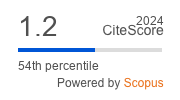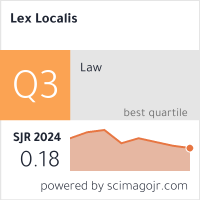Role of Legal Systems in Facilitating GovernmentPolicy in Inclusive Education for Autistic Children:Lessons from Comparative Jurisdictions
DOI:
https://doi.org/10.52152/23.2.41-65(2025)Keywords:
government innovation initiatives, availability of resources and support services, law model and legal systems, teachers’ preparedness, school leadership, policy development for autistic children, stakeholder satisfactionAbstract
This paper explains how these governments and laws affect the education of autistic children in the classroom as the inclusion dominant continues to advance and the cases of autism increases. Based on a mixed-methods design for self-administered online surveys and semi-structured interviews, it includes 150 participants from Zhejiang Province ranging from teachers, parents and policymakers and seeks to evaluate satisfaction levels, challenges faced, and services provided to them. Smart PLS software was used for data analysis to assess the structural relationships between the study’s variables. Thus, the purpose of the research is to explain the significance and model adaptations involved in translating public policy into practice in the context of education. Stakeholders will benefit from the findings of the research in the following ways: The main findings of the research highlight the pivotal role of legal structures in mediating the success of government initiatives, shedding light on disparities, challenges, and effective strategies that influence the educational landscape for autistic learners and all-inclusive learning environment in the Zhejiang Province. The need for continual collaboration between legal systems and educational innovation remains paramount to achieving sustained, meaningful inclusion.
References
Abdel Karim, A. E., & Mohammed, A. H. (2015). Effectiveness of sensory integration program in motor skills in children with autism. Egyptian Journal of Medical Human Genetics, 16(4), 375-380. doi:10.1016/j.ejmhg.2014.12.008
Adams, C. A., Muir, S., & Hoque, Z. (2014). Measurement of sustainability performance in the public sector. Sustainability Accounting, Management and Policy Journal, 5(1), 46-67. doi:10.1108/SAMPJ-04-2012-0018
Ayasrah, M. N., & Khasawneh, M. A. S. (2023). Reintegrating psychological innovations to improve mental and psychological health in children with autism. Clinical Schizophrenia & Related Psychoses, 17(S2). doi:10.3371/CSRP.MMWY.100148
Azila-Gbettor, E. M., Abiemo, M. K., & Glate, S. N. (2023). University support and online learning engagement during the Covid-19 period: The role of student vitality. Heliyon, 9(1), e12832. doi:10.1016/j.heliyon.2023.e12832
Berryessa, C. M. (2017). Educator of the court: The role of the expert witness in cases involving autism spectrum disorder. Psychology, Crime and Law, 23(6), 575-600. doi:10.1080/1068316X.2017.1284218
Brede, J., Remington, A., Kenny, L., Warren, K., & Pellicano, E. (2017). Excluded from school: Autistic students’ experiences of school exclusion and subsequent re-integration into school. Autism and Developmental Language Impairments, 2, 55-59. doi:10.1177/2396941517737511
Damnjanovic, V., Jednak, S., & Mijatovic, I. (2015). Factors affecting the effectiveness and use of Moodle: Students’ perception. Interactive Learning Environments, 23(4), 496-514. doi:10.1080/10494820.2013.789062
Dawson, G., & Watling, R. (2000). Interventions to facilitate auditory, visual, and motor integration in autism: A review of the evidence. Journal of Autism and Developmental Disorders, 30(5), 415-421.
Del Viva, M. M., Igliozzi, R., Tancredi, R., & Brizzolara, D. (2006). Spatial and motion integration in children with autism. Vision Research, 46(8-9), 1242-1252. doi:10.1016/j.visres.2005.10.018
Dingfelder, H. E., & Mandell, D. S. (2011). Bridging the research-to-practice gap in autism intervention: An application of diffusion of innovation theory. Journal of Autism and Developmental Disorders, 41(5), 597-609. doi:10.1007/s10803-010-1081-0
Divan, G., Bhavnani, S., Leadbitter, K., Ellis, C., Dasgupta, J., Abubakar, A., . . . Green, J. (2021). Annual research review: Achieving universal health coverage for young children with autism spectrum disorder in low- and middle-income countries: A review of reviews. Journal of Child Psychology and Psychiatry and Allied Disciplines, 62(5), 514-535. doi:10.1111/jcpp.13404
Drahota, A., Sadler, R., Hippensteel, C., Ingersoll, B., & Bishop, L. (2020). Service deserts and service oases: Utilizing geographic information systems to evaluate service availability for individuals with autism spectrum disorder. Autism, 24(8), 2008-2020. doi:10.1177/1362361320931265
Dymond, S. K., Gilson, C. L., Myran, S. P., & Champaign, U. (2007). Services for children what needs to change ?. Journal of Disability Policy Studies, 18(3), 133-147.
Finch, K., Watson, R., Macgregor, C., & Precise, N. (2013). Teacher needs for educating children with autism spectrum disorders in the general education classroom. The Journal of Special Education Apprenticeship, 2(2), 1-26.
Forrest, D., & Godwin, L. (2016). Proceedings of the International Society for Music Education 32nd World Conference on Music Education. Melbourne, Australia: International Society for Music Education.
Goodwin, M. S. (2008). Enhancing and accelerating the pace of autism research and treatment: The promise of developing innovative technology. Focus on Autism and Other Developmental Disabilities, 23(2), 125-128. doi:10.1177/1088357608316678
Graetz, J. E. (2010). Autism grows up: Opportunities for adults with autism. Disability and Society, 25(1), 33-47. doi:10.1080/09687590903363324
Hamrick, J., Cerda, M., O’Toole, C., & Hagen-Collins, K. (2021). Educator knowledge and preparedness for educating students with autism in public schools. Focus on Autism and Other Developmental Disabilities, 36(4), 213-224. doi:10.1177/1088357621989310
Hodgetts, S., Zwaigenbaum, L., & Nicholas, D. (2015). Profile and predictors of service needs for families of children with autism spectrum disorders. Autism, 19(6), 673-683. doi:10.1177/1362361314543531
Knight, V. F., Huber, H. B., Kuntz, E. M., Carter, E. W., & Juarez, A. P. (2019). Instructional practices, priorities, and preparedness for educating students with autism and intellectual disability. Focus on Autism and Other Developmental Disabilities, 34(1), 3-14. doi:10.1177/1088357618755694
Krejcie, R. V, & Morgan, D. W. (1970). Sample size determination. Business Research Methods. Educational and Psychological Measurement, 4(5), 34-36.
Lanaj, K., Johnson, R. E., & Barnes, C. M. (2014). Organizational behavior and human decision processes beginning the workday yet already depleted ? Consequences of late-night smartphone use and sleep. Organizational Behavior and Human Decision, 124(1), 11-23. doi:10.1016/j.obhdp.2014.01.001
Lerner, M. D., Haque, O. S., Northrup, E. C., Lawer, L., & Bursztajn, H. J. (2012). Emerging perspectives on adolescents and young adults with high-functioning autism spectrum disorders, violence, and criminal law. Journal of the American Academy of Psychiatry and the Law, 40(2), 177-190.
Marsack-Topolewski, C. N., & Weisz, A. N. (2020). Parents’ perceptions of access to services for their adult children diagnosed with autism spectrum disorder. Families in Society, 101(2), 190-204. doi:10.1177/1044389419881273
Md Jani, S. H., Salleh, N., Mohd Ali, N. A., & Abdul Rasool, M. S. (2022). Adapting public-private partnership as strategic collaboration between government and philanthropy-based autism spectrum disorder centre. International Journal of Academic Research in Business and Social Sciences, 12(1). doi:10.6007/ijarbss/v12-i1/12283
Pawitan, G., Nawangpalupi, C. B., & Widyarini, M. (2017). Understanding the relationship between entrepreneurial spirit and global competitiveness: Implications for Indonesia. International Journal of Business and Society, 18(S2), 261-278.
Rava, J., Shattuck, P., Rast, J., & Roux, A. (2017). The prevalence and correlates of involvement in the criminal justice system among youth on the autism spectrum. Journal of Autism and Developmental Disorders, 47(2), 340-346.
Renty, J., & Roeyers, H. (2006). Satisfaction with formal support and education for children with autism spectrum disorder: The voices of the parents. Child: Care, Health and Development, 32(3), 371-385. doi:10.1111/j.1365-2214.2006.00584.x
Roberts, J., & Webster, A. (2022). Including students with autism in schools: A whole school approach to improve outcomes for students with autism. International Journal of Inclusive Education, 26(7), 701-718. doi:10.1080/13603116.2020.1712622
Roux, A. M., Garfield, T., & Shattuck, P. T. (2019). Employment policy and autism: Analysis of state Workforce Innovation and Opportunity Act (WIOA) implementation plans. Journal of Vocational Rehabilitation, 51(3), 285-298. doi:10.3233/JVR-191046
Rowe, K. (2015). Caffeine intake, influences and experiences: The development of CaffCo: A New Zealand caffeine consumption habits questionnaire (Master’s thesis, Massey University, Albany, New Zealand). Retrieved from http://hdl.handle.net/10179/7881
Schiavio, A., & Benedek, M. (2020). Dimensions of musical creativity. Frontiers in Neuroscience, 14. doi:10.3389/fnins.2020.578932
Schoen, S. A., Lane, S. J., Mailloux, Z., May-Benson, T., Parham, L. D., Smith Roley, S., & Schaaf, R. C. (2019). A systematic review of Ayres sensory integration intervention for children with autism. Autism Research, 12(1), 6-19. doi:10.1002/aur.2046
Searing, B. M. J., Graham, F., & Grainger, R. (2015). Support needs of families living with children with autism spectrum disorder. Journal of Autism and Developmental Disorders, 45(11), 3693-3702. doi:10.1007/s10803-015-2516-4
Shoaib, M., Hussain, I., Mirza, H. T., & Tayyab, M. (2017, July). The role of information and innovative technology for rehabilitation of children with Autism: A Systematic Literature Review. In 2017 17th International Conference on Computational Science and Its Applications (ICCSA) (pp. 1-10). Piscataway, NJ: IEEE. doi:10.1109/ICCSA.2017.7999647
Solari, E. (2014). Longitudinal prediction of 1st and 2nd grade English oral reading fluency in ELL. Journal of Adolescence, 74(4), 274-283. doi:10.1002/pits
Stadnick, N. A., Meza, R. D., Suhrheinrich, J., Aarons, G. A., Brookman-Frazee, L., Lyon, A. R., . . . Locke, J. (2019). Leadership profiles associated with the implementation of behavioral health evidence-based practices for autism spectrum disorder in schools. Autism, 23(8), 1957-1968. doi:10.1177/1362361319834398
Stahmer, A. C., Suhrheinrich, J., Yu, Y., Melgarejo, M., Schetter, P., & Young, G. A. (2023). Implementation readiness for evidence-based autism practices in school systems. Implementation Research and Practice, 4. doi:10.1177/26334895231199465
Wallace, S., Fein, D., Rosanoff, M., Dawson, G., Hossain, S., Brennan, L., . . . Shih, A. (2012). A Global Public Health Strategy for Autism Spectrum Disorders. Autism Research, 5(3), 211-217. doi:10.1002/aur.1236
Webster, A., & Roberts, J. (2022). Implementing the school-wide autism competency model to improve outcomes for students on the autism spectrum: A multiple case study of three schools. International Journal of Inclusive Education, 26(8), 796-814. doi:10.1080/13603116.2020.1735540
Yu, Y., Bradley, C. C., Boan, A. D., Charles, J. M., & Carpenter, L. A. (2021). Young adults with autism spectrum disorder and the criminal justice system. Journal of Autism and Developmental Disorders, 51(10), 3624-3636. doi:10.1007/s10803-020-04805-9
Zirkel, P. A. (2011). Autism litigation under the IDEA: A new meaning of" disproportionality"?. Journal of Special Education Leadership, 24(2), 92-103.
Downloads
Published
Issue
Section
License
Copyright (c) 2025 Lex localis - Journal of Local Self-Government

This work is licensed under a Creative Commons Attribution-NonCommercial-NoDerivatives 4.0 International License.








